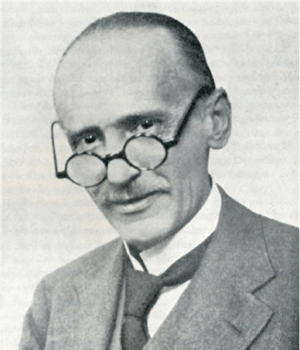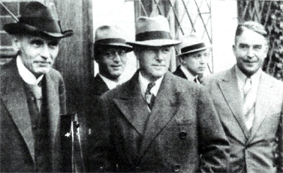Otfrid Foerster facts for kids
Otfrid Foerster (born November 9, 1873, died June 15, 1941) was a famous German doctor. He was a neurologist (a brain and nerve doctor) and a neurosurgeon (a surgeon who operates on the brain and nerves). Foerster made many new discoveries in these fields. For example, he found ways to treat muscle stiffness (called spasticity) and severe pain. He also developed tests for epilepsy and performed the first brain surgeries for this condition. He was the first to map out "dermatomes," which are areas of your skin connected to specific nerves. He also helped create maps of the brain's motor cortex, which controls movement.
Contents
Early Life and Studies
Otfrid Foerster was born in Breslau, which is now called Wrocław in Poland. His father was Richard Foerster. Otfrid went to the Maria Magdalenen Gymnasium, a type of high school, and finished in 1892.
From 1892 to 1896, he studied medicine in different cities like Freiburg, Kiel, and Breslau. He earned his medical license and doctorate degree in 1897. After his studies, he spent two years learning more abroad. He went to Paris to study with famous doctors like Joseph Jules Dejerine and Joseph Babinski. He also went to Switzerland to learn about physical therapy for patients with nerve problems.

Discovering New Treatments
When Foerster was a student, the field of neurology was just starting to become its own special area of medicine. Doctors like Karl Wernicke, who worked with Foerster, were very interested in how different parts of the brain controlled different body functions. This made Foerster very interested in the anatomy (structure) of the central nervous system (your brain and spinal cord).
In 1903, Foerster and Wernicke published an atlas, which is like a detailed map, of the brain. At that time, doctors were mostly focused on figuring out what was wrong with patients (diagnosis). It was hard to find effective treatments. Foerster had a new idea: using physical therapy to help people with nerve problems.
He also studied how muscles move and coordinate. This led him to understand muscle stiffness, known as spasticity. In 1908, Foerster developed a special surgery called rhizotomy. This operation involved carefully cutting certain sensory nerves in the spinal cord to help reduce severe muscle stiffness.
Innovations in Brain Surgery
In 1915, Foerster shared his amazing results about treating nerve damage from injuries, including gunshot wounds. He also worked on other types of damage to the spinal cord and brain.
Between 1922 and 1924, Foerster went to Russia to help treat Vladimir Lenin, a very important political leader, after he had a stroke. After Lenin passed away, Foerster was asked to suggest a scientist to study Lenin's brain. He recommended Oskar Vogt. Foerster's signature was on all the official documents about Lenin's treatment and death.
Later, in Germany, Foerster faced difficulties. Even though he did not support the National Socialists (Nazis), his work was limited. This was partly because of his past connection to Lenin and because his wife had some Jewish heritage. Also, a grant from the Rockefeller Foundation in 1932 helped build a modern lab for his Institute of Neurology. In 1934, he lost his special professorship, and in 1938, he was removed from his university professor role.
Training Future Doctors
Between the two World Wars (from 1925 to 1935), Breslau became a popular place for doctors from all over the world, especially the United States, to learn about neurology and neurosurgery.
One of his early students was Wilder Penfield. Penfield continued Foerster's work on understanding how the cerebral cortex (the outer part of the brain) controls movement and how to study epilepsy. Other important students included Percival Bailey, who created a new way to classify brain tumors, and Paul Bucy, who discovered the famous Klüver-Bucy syndrome. Many other famous doctors also visited Foerster to learn from him.
One of Foerster's important methods was to use local anesthesia during brain surgery. This meant the patient was awake during the operation. While the patient was awake, Foerster would gently touch parts of their brain with an electronic needle. He would then observe the patient's reactions, like hand or finger movements. This helped him learn more about the brain's motor cortex, which controls all our movements.
In 1935, Foerster received the Hughlings Jackson Memorial Medal in London. This was an international award that he valued very much. However, he did not receive any German honors between 1933 and his death.
Foerster passed away in 1941 in Breslau at the age of 67.
Lasting Impact and Recognition
Foerster's important role in German neurology was recognized in 1924. He became the president of the German Society of Neurology and held that position for eight years until 1932.
From 1925 to 1935, Foerster used all the latest scientific methods in his research, including electrophysiology. This field measures or creates electrical signals in tissues, like the brain. He did important work on how electrical signals are involved in nerve problems.
With help from the Rockefeller Foundation and the State of Prussia, Foerster was able to open a new Institute of Neurological Research in 1934. This institute was later named the Otfrid Foerster Institut Für Neurologie in his honor. Otfrid Foerster also helped edit a huge textbook on neurology and wrote many chapters for it.
His biographers (people who write about his life) described him as a giant in neurosurgery. They said he was very intelligent, kind, and charming. He spoke several languages fluently and was a very active speaker and writer. He published over 300 papers and several books.
The German Society of Neurosurgery honors his name with the Otfrid-Foerster-Medaille und -Gedächtnisvorlesung (Otfrid Foerster Medal and Memorial Lecture). This award was created on August 26, 1953, to remember his great contributions.
Works
- Physiologie und Pathologie der Coordination, Jena 1902
- Atlas des Gehirns, herausgegeben von Karl Wernicke, Berlin 1903
- Beiträge zur Hirnchirurgie, Berlin 1909
- Die Kontrakturen bei den Erkrankungen der Pyramidenbahn, Berlin 1909
- Über die operative Behandlung spastischer Lähmungen mittels Resektion der hinteren Rückenmarkswürzel, Berlin 1911
- Zur Pathogenese und chirurgische Behandlung der Epilepsie, Leipzig 1925
- Der Schmerz und seine operative Behandlung, Halle 1935



